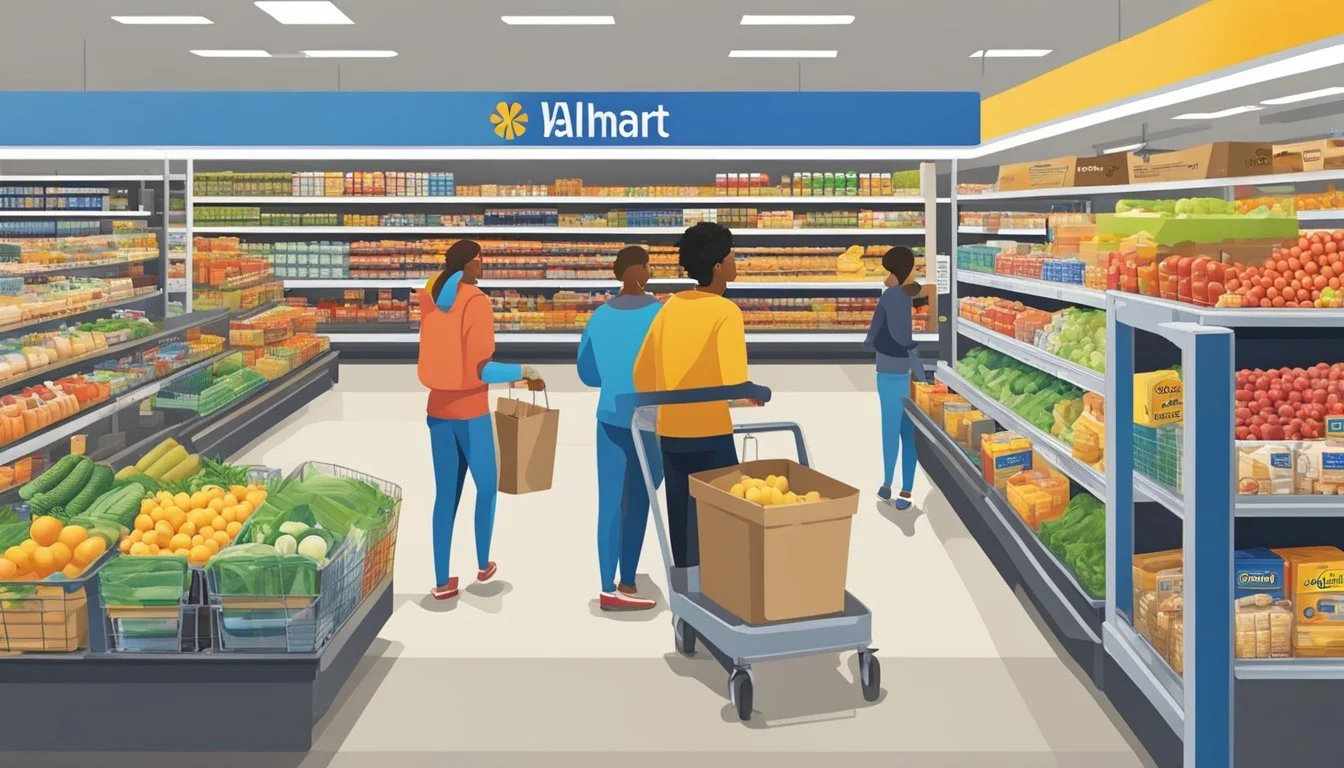Walmart vs Lidl
A Comprehensive Comparison of Grocery Shopping Experiences
Comparing grocery stores is more than just a matter of price; it's about the shopping experience, product selection, store layout, and overall value. Walmart and Lidl are two retail giants that have become go-to destinations for grocery shoppers. Walmart, a household name in America, prides itself on its wide-ranging inventory covering nearly every category imaginable, from electronics to groceries. With its competitive pricing and nationwide presence, Walmart is often favored for one-stop shopping.
On the other hand, Lidl, a relative newcomer to the U.S. market but a well-established name in Europe, offers a different approach. Its stores focus on high-quality, affordable groceries, featuring an array of private-label brands alongside a smaller selection of household products. Lidl's business model prioritizes efficiency and sustainability, often reflected in store design and product packaging. With a layout that promotes a straightforward shopping experience and an emphasis on fresh, local produce, Lidl appeals to those who prioritize food quality and a convenient shopping experience.
As consumers weigh their options, the choice between Walmart and Lidl hinges on individual shopping preferences and priorities. Whether it's the extensive range of products at Walmart or the curated selection and European flair of Lidl, each store has its own set of advantages that cater to different customer needs.
Company Profiles
In comparing Walmart and Lidl, it is essential to consider the origins and development of these retail giants to understand their current market positions.
History of Walmart
Walmart was established by Sam Walton in 1962 in Rogers, Arkansas. The company embarked on a mission to provide customers with low prices and great value. Walton's vision was to achieve higher sales volumes by keeping sales prices lower than his competitors. Walmart rapidly expanded throughout the United States, and it became synonymous with the concept of a one-stop shop due to its wide variety of goods.
Founded: 1962, Rogers, Arkansas, USA
Founder: Sam Walton
Type: Public
Expansion: Walmart went public in 1970, and by the end of the decade, it operated 276 stores in 11 states.
Walmart's rise to prominence as a global retailer stems from its emphasis on customer satisfaction through low prices and the convenience of having a wide range of products under one roof.
History of Lidl
Lidl is a global discount supermarket chain that originated in Germany in the 1970s. The company has a long-standing reputation for its discount prices, straightforward shop layouts, and a rotating selection of non-food items.
Founded: 1973, Ludwigshafen, Germany
Founder: Josef Schwarz
Type: Private
Expansion: Throughout the 1990s, Lidl began its expansion outside of Germany and now operates in numerous countries across Europe and beyond.
Lidl's success can be largely attributed to its streamlined operational processes, efficient supply chains, and focus on simplicity that allows for competitive pricing structures.
Market Presence
Walmart and Lidl represent two of the significant players in the grocery store industry, both with noteworthy market presence. Their strategic location distribution and market share give a clear indication of their influence in the grocery sector.
Global Reach and Locations
Walmart boasts an extensive global reach, with a strong emphasis on its presence in the United States, where it operates a vast network of stores across all 50 states. The number of Walmart stores makes it one of the largest grocery store chains on both the East Coast and nationwide. Additionally, Walmart has international locations, reinforcing its status as a global supermarket giant.
Lidl, originating in Germany, also holds a formidable global presence, primarily throughout Europe. In the United States, Lidl has been expanding its footprint particularly along the East Coast, where it continues to establish new stores. Despite its relatively recent entry into the U.S. market, Lidl’s international presence includes thousands of stores across multiple countries, signifying its rapid growth and expanding influence.
Market Share
Walmart holds a significant portion of the U.S. grocery market share, being one of the leading grocery retailers. It has managed to integrate grocery sales as a major part of its business model. Walmart's ability to offer a wide variety of products at competitive prices has helped it capture a noteworthy share of the market.
Lidl, though a newer entrant in the United States compared to Walmart, has quickly gained a strong market presence, showing notable sales figures and market penetration. It is recognized for its efficiency and lower-cost business model, which has garnered a growing market share, especially in regions where cost-conscious consumers are prevalent.
Product Range and Quality
When comparing Walmart and Lidl, it's important to examine the variety and caliber of items offered, especially focusing on grocery, fresh produce, meat, dairy, and store-brand products.
Grocery and Fresh Produce
Walmart boasts a wide array of grocery items, including a vast selection of fresh produce. With a product count that often surpasses 120,000 items, customers can find not only common fruits and vegetables but also international and organic selections. Lidl, while having a smaller footprint, dedicates substantial effort to ensuring fresh produce quality, offering a curated range that covers the essential needs of a household.
Meat and Dairy Offerings
Both stores offer a variety of meat and dairy products, with Walmart providing a diverse range of both conventional and organic options. Customers have access to various cuts of meat and a broad selection of dairy goods. Lidl's offerings, while potentially more limited than Walmart's, are sourced to ensure quality, with periodic deals on specific items like cheese or cold cuts.
Store Brand Products
The reputation of store brand products is crucial to both retailers. Walmart's Great Value line extends across many categories, giving shoppers a price-competitive alternative to national brands. Lidl's own brand items are also similar in quality to national brands, often priced approximately 20% cheaper, with a strong emphasis on matching the taste and quality expectations of their customers.
Pricing and Cost-Saving
When choosing between Walmart and Lidl, consumers are often concerned with getting the most value for their money, making pricing and cost-saving opportunities a significant factor in the decision-making process.
General Pricing Comparison
Walmart boasts a vast selection with around 120,000 products available, which often allows for aggressive pricing strategies across various categories. They commonly offer low prices on a broad range of items beyond groceries, consistently positioning themselves as a discount grocer. Lidl, with an average of 3,500 products, typically promotes affordable prices on its more curated selection. It's worth noting that because of their differing ranges, price comparisons can vary; however, both stores have proven to provide savings to their customers, with specific categories being cheaper at one retailer over the other.
Discount and Saving Strategies
Walmart:
Uses Rollback prices and in-store promotions
Provides a Savings Catcher feature in their app
Offers discounts on bulk purchases
Lidl:
Centralizes savings through their own branded products
Weekly specials and discounted items highlighted in store
"Lidl Surprises" with limited time deals on non-grocery items
Both stores entail a different approach to saving strategies. Customers are encouraged to compare based on their shopping preferences and the specific items they intend to purchase.
Shopping Experience
When choosing between Walmart and Lidl for grocery shopping, customers often consider the quality of the shopping experience, especially checkout efficiency and customer service quality.
Checkout Efficiency
Walmart and Lidl both understand that a smooth checkout process is critical for customer satisfaction. Walmart offers multiple checkout options including self-checkout stations, staffed registers, and recently, a mobile checkout system that allows customers to pay on the go using the Walmart app. The use of advanced technology aims to reduce wait times and enhance the checkout experience for their customers. On the other hand, Lidl's checkout process is structured around efficiency: its conveyor belt system is designed to move products quickly, and payment transactions are handled swiftly, often resulting in shorter lines at checkout.
Customer Service Quality
Customer service at Walmart and Lidl is a reflection of their overall brand strategies. Walmart has a vast workforce and extensive training programs, which enable them to cater to customer queries and assistance requests efficiently. With a focus on being competitive in the retail space, Walmart aims to provide a consistent level of service across its countless locations.
Lidl places a strong emphasis on friendliness and a helpful attitude. Although they may have fewer staff than Walmart on the floor at any given time due to their smaller store sizes, the training Lidl provides ensures their employees are knowledgeable about the store's products and layout, enabling them to assist customers effectively when needed.
Additional Services
When choosing between Walmart and Lidl, consumers have access to various additional services that enhance their shopping experience, particularly in terms of payment, financing options, and the convenience of shipping and in-store services.
Payment and Financing Options
Walmart offers multiple payment and financing options, including:
Free Shipping Policies: Standard shipping is free on eligible orders.
Apple Pay Later Financing: Available in-store for easy checkout.
Shop Pay Installments: Not explicitly supported.
PayPal Pay Later: Accepted for online purchases.
Affirm Financing Support: Customers can buy now and pay over time.
Lidl does not promote the same range of financing services, but shoppers can expect:
Price Matching Policies: Not commonly practiced.
Standard payment methods including credit/debit cards.
Shipping and In-Store Services
Walmart excels with an array of shipping and in-store services such as:
In-Store Pickup: Free and convenient, with dedicated pickup areas.
Order Tracking Support: Robust system for monitoring online purchases.
Lidl focuses more on the in-store experience with services like:
Special in-store promotions and deals.
Quick checkout lines for efficient shopping.
Both retailers aim to provide services that offer convenience, albeit with Walmart taking the lead in online and financing options, while Lidl keeps it straightforward with a focus on in-store efficiency.
Promotions and Discounts
Both Walmart and Lidl offer a variety of promotion and discount options, catering to different customer preferences and loyalty habits. They employ strategic pricing through loyalty programs and coupon offerings to attract and retain customers.
Loyalty Programs
Walmart does not offer a traditional loyalty program but provides savings through its Walmart Rewards Card and Walmart+, which includes benefits like free shipping and discounts on fuel. Lidl, on the other hand, operates the Lidl Plus app, granting customers access to personalized coupons and offers.
Coupons and Deal Offerings
Walmart:
Offer Codes: Regularly available on its website and through promotional emails.
Customer-Specific Discounts: Discounts available for veterans, students, and teachers via third-party programs.
Essential Worker Discounts: Occasionally available through special promotions.
Lidl:
Discount Codes: Users can access in the Lidl Plus app.
Veteran's Discount Policies: Specific discount policies for veterans are not widely advertised.
Birthday Discount Policies: Promotions may be offered through the Lidl Plus app.
Both stores periodically offer government employee discounts but generally do not have standing discount policies for these groups. They each have different strategies, with Walmart focusing on a broader approach and Lidl targeting personalized savings.
Brand and Corporate Policies
When assessing the brand and corporate policies of Walmart and Lidl, it is vital to consider their sustainability initiatives and commitment to community engagement and inclusivity. Both brands have laid out policies addressing these areas, though their approaches and the extent of their commitments vary.
Sustainability and Ethics
Walmart has a longstanding Sustainability Commitment, which includes goals to power its operations with 100% renewable energy, achieve zero waste in key markets, and offer sustainable products. It has also made pledges regarding the reduction of greenhouse gas emissions in alignment with the Paris Agreement.
Lidl aligns with sustainability through various practices, encompassing energy-efficient stores and operations, and partnerships with certification organizations to offer sustainably sourced products. Lidl's commitment extends to offering a selection of organic and locally sourced products, reducing its carbon footprint, and implementing a robust recycling program.
Inclusivity and Community Engagement
Walmart's approach to inclusivity includes a Commitment to Racial Equity through initiatives aimed at addressing racial disparities in society. It focuses on fostering diversity and supporting minority-owned businesses. By investing in communities and promoting diversity among its suppliers, Walmart strives to contribute positively to societal equity.
Lidl’s corporate policies encompass community engagement efforts, with activities focused on supporting local initiatives and contributing to the wellbeing of the communities they serve. This includes charitable partnerships, food donations, and efforts to ensure their store environments are welcoming and accessible to all customers.
Consumer Engagement
Engaging with consumers is key for grocery retailers. Both Walmart and Lidl use innovative strategies to interact with their clientele, utilizing different platforms and campaigns to bolster their brand presence and customer relationships.
Online Presence and Reviews
Walmart has a robust online presence, exemplified by a comprehensive website and active social media engagement. Their website serves as a one-stop shop, offering an extensive range of products, customer reviews, and the option for grocery pick-up or delivery services. Walmart's review system allows consumers to openly share their purchasing experiences, contributing to the store's transparency and accountability.
Brand Recognition: Walmart leverages its well-established brand by keeping a consistent and highly visible online profile.
Websites: They maintain an easy-to-navigate website that provides an efficient shopping experience.
Outside Expert Reviews: Expert reviews often highlight Walmart’s ability to offer a wide variety of goods at competitive prices, reinforcing their position in the market.
Lidl is known for its high-quality yet affordable products, and this is reflected in the consumer feedback seen online. Lidl's website is user-friendly, provides weekly deals, and showcases their products effectively. They do not offer the same breadth of e-commerce functionality as Walmart, focusing more on in-store experiences.
Brand Recognition: Lidl's smaller but growing online footprint is often associated with their strong European roots and spread to the U.S. market.
Influencer Marketing Programs: Lidl's approach includes collaborations with local and regional influencers to attract a diverse customer base.
Marketing Strategies
Walmart's marketing efforts employ a variety of platforms, ranging from traditional print advertisements to digital campaigns. They are known for rolling out extensive holiday sales and back-to-school promotions that attract significant consumer attention.
Influencer Marketing Programs: Walmart runs influencer partnerships and sponsorships to show their products in real-life settings, further engaging consumers.
Lidl uses targeted promotional strategies to entice shoppers, such as their "Lidl Surprises" campaign, which introduces new products every week. They promote a unique shopping experience heavily oriented around discounts and product discovery.
Marketing Strategies: Lidl thrives on creating a sense of urgency and 'treasure hunt' shopping experience through both their in-store signage and digital outreach efforts.
Both retailers understand the value of engaging with their customers through effective marketing, with Walmart focusing on a wide-reaching, multi-platform approach, and Lidl capitalizing on exclusivity and curiosity-driven campaigns.
Conclusion
The choice between Walmart and Lidl largely comes down to individual shopping preferences and priorities. Walmart excels in offering lower prices in several key categories, including beverages, baking goods, dairy, and dry goods. Its vast network of stores and broad product range caters to one-stop shoppers seeking convenience and value.
Lidl, on the other hand, competes strongly on price in areas such as canned goods, frozen foods, personal care, and cleaners. Shoppers with a focus on these categories might find better savings. Furthermore, Lidl's commitment to quality often leads consumers to prefer their store-brand offerings.
Shoppers should consider the following:
Budget: Walmart's price competitiveness across various categories can help keep the grocery bill lower.
Quality Concerns: Lidl's emphasis on product quality may appeal to those who prioritize the standard of their purchases.
Shopping Experience: Walmart's sheer size offers more options, while Lidl's curated selection might simplify decision-making.
Convenience: Walmart’s numerous locations might make it a more accessible choice for many.
Ultimately, some consumers may benefit from shopping at both retailers, taking advantage of Walmart's price points in certain categories and Lidl's competitive pricing and quality in others. It's recommended that customers assess their shopping lists against each store's strengths and make an informed decision based on their specific needs.
More About Walmart
Walmart vs Albertsons Quality







